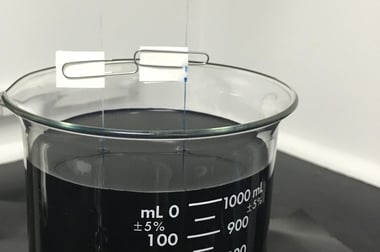 Manufacturers of wire and cable understand the importance of preventing moisture from making contact with fiber optics. Conducting a water wicking test for yarn and thread used in the manufacturing process can help with product evaluation, as well as save time and money in the long term.
Manufacturers of wire and cable understand the importance of preventing moisture from making contact with fiber optics. Conducting a water wicking test for yarn and thread used in the manufacturing process can help with product evaluation, as well as save time and money in the long term.
How does a wicking test help? Consider what happens when water makes contact with copper wire. It can degrade the signal, throw off light waves, as well as create impurities and oxidation. Additionally, moisture can become trapped inside the antenna connector as a result of repeated exposure to significant swings in temperature and atmospheric pressure in the presence of significant relative humidity.
Wicking refers to the tendency of a yarn or other fiber to draw liquids into the strands through capillary action. A wicking test helps producers of wire and cable evaluate the characteristics of yarn – aiding in the best fiber selection to be used in the manufacturing of products for non-wicking applications.
Finding the best non-wicking thread and yarn through the process of conducting a wicking test, manufacturers can be assured that the fiber used will provide a water-resistant material that allows the exterior coating and seams to bond more strongly and resist mold and other fungal growth, making the structure stronger and more durable. The test is simple, low cost and doesn’t require 3rd party assistance.
Non-Wicking Test by Service Thread
Industrial Yarn and Thread Wicking Test Procedure
The recommended wicking test method for yarn and thread involves suspending the subject yarn into a dye solution and timing the capillary action. The samples must be clean and free from knots. Testers select unbroken, twisted fibers for sampling. Preshrunk yarns that are natural, white or evenly dyed provide the most accurate results.
Testers attach lead weights to one end of three samples, each 18 inches long, and then attach the other ends to a lab stand crossbar. Filter paper is attached to the samples about 3 inches from the end, and the yarn samples are lowered into a beaker with about 3 inches of Methylene Blue-water solution until the filter paper is about 1 inch above the top of the beaker.
At this point, the lab worker records the time that the test began and checks on the yarns periodically, noting the time at which the bottom of the filter paper is wetted. If this time is 6 hours or longer, the fiber is considered "non-wicking" and appropriate for use in applications where moisture is a detrimental factor to the end product.
Without a non-wicking treatment, any moisture that the yarns are exposed to near a splice, through a seam rupture, or through a defect in the outer jacket could be drawn into the cable potentially resulting in signal loss and/or failure. Knowing how to test moisture wicking properties of yarns and fibers can save you time, money and frustration, while providing both structural strength and visual appeal to your projects.
If you’re a manufacturer of wire and cable, you understand some of the challenges of processing textiles into various cable designs. Download our ebook Process Engineering Guide for Textiles in Wire & Cable, below to learn more about best practices and the latest processing tools available to help control yarn tension and other variables.



